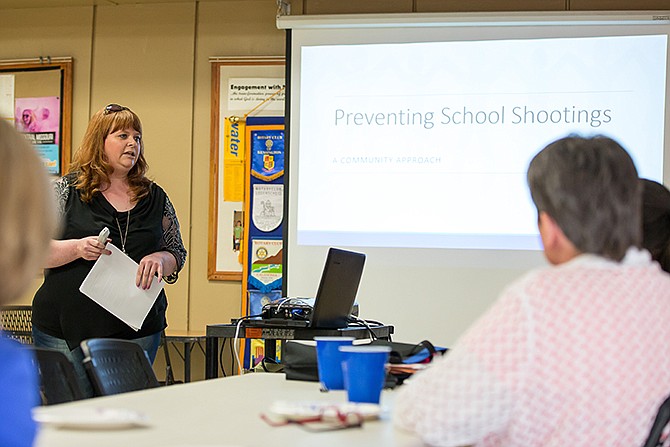Susan Cook recently earned a master's degree in sociology - and her studies included a concentration on school shootings.
"After every single shooting, the town always said, 'We never thought it would happen here,'" Cook said at the beginning of a 40-minute presentation Tuesday to the Jefferson City Evening Rotary Club. "We all want to think that it's not going to happen where we live - that it affects somebody else, somewhere else, and that we're not connected to the violence."
But most of the school shootings have been in rural or suburban settings with populations less than 50,000, she said.
Operations manager for Empower Missouri, a social justice and welfare agency organization, Cook said she's read numerous books and papers on school shootings in the United States.
The main conclusion she's drawn is: "We all have to come together, to figure out a solution to prevent it from happening."
But it's hard to predict potential school shootings ahead of time because school shooters are vastly different, Cook said.
"There's not a profile to be able to pinpoint and look at and say, 'If this child has all these characteristics, he's going to become a school shooter.' It just doesn't exist," she said.
Circumstances, behaviors and threats are the main things to focus on, she said.
Her talk is based on research of shootings from 1925-2011, involving 120 cases around the world in high schools and colleges.
Cook did not address or comment on shootings outside of schools, like the recent Dallas police killings or the Orlando nightclub massacre.
She noted 97 percent of the shooters were male; 76 percent were teens or in their early 20s; 60 percent occurred in January-June - the second half of a school year - with 15 percent of those in April, the same month as the 1999 shooting at Columbine, Colorado, High School.
Cook noted 65 school shooters or thwarted shooters have claimed Columbine was a motivation for their own actions.
"The good news is that a mass shooting (generally) is not an impulsive crime - and therein lies the promise in stopping it," Cook said. "On average, a mass shooting is planned for six-plus months in advance."
Follow-up investigations after shootings have found most shooters "plan this, talk about it, write about it (in their journals)," she said, "and we don't catch it most of the time."
In nearly every case, she noted, there were warning signs, but people have to begin paying attention to those signs starting with believing "humans are capable of this."
Cook noted many want to blame the shootings on mental illness - and it's true many of the shooters were found to be clinically depressed.
Her research found most of the student shooters came from two-parent homes, were doing well in school and had friends. Half were involved in after-school activities, Cook said, and two-thirds "had never been in serious trouble."
And while four out of five had a history of suicide attempts or suicidal thoughts, she said, most of those who were seeing a counselor or psychiatrist didn't reveal their potential for violence or even that they were having such thoughts.
One predictor of potential trouble is that 98 percent of school shooters "experienced some sort of failure immediately preceding the attack," she said. The "failures" were different things for different people.
In almost all the cases, Cook added, the shooters told someone about their plans ahead of time but generally weren't believed.
Adults need to be seen as safe and trusted, Cook said, encouraging kids to speak up if they've heard someone make or suggest a threat.
We also need to provide more mental health services in schools, she said, and "fix fragmentation" where teachers may spot a problem but not share it with their colleagues who also have the student who might be causing concerns.
School shootings are only a small portion of the nation's violent incidents, she said.
"Schools still are one of our safest places," she said.
__
Correction: An ABC News study found that 65 shooters or thwarted shooters claimed the April 2009 killing of 12 students and a teacher at Columbine, Colorado, High School as a motivation for their separate shootings or attempts. The number was reported incorrectly in the original version of this story. The text above has since been corrected.

